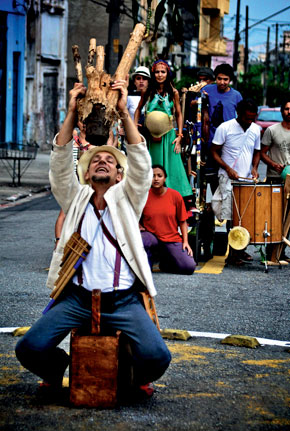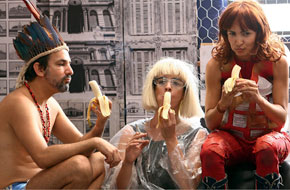 CIA. SÃO JORGE DE VARIEDADES
CIA. SÃO JORGE DE VARIEDADES"Barafonda", playing in Barra FundaCIA. SÃO JORGE DE VARIEDADES
The end of the twentieth century also left behind the period that, at least in the São Paulo city theatrical milieu, was known as “the era of the directors.” José Celso Martinez Corrêa, Antunes Filho and Gerald Thomas did memorable work staging plays, but methodologies headed by authorities, at the turn of the millennium, no longer seemed to seduce a new generation of artists. Thereafter, a new type of production gained strength, one more open to participation – or to co-authorship – of the actors, of the lighting professionals and of the scenographers. This was when what may come to be known as “the era of collective work” was established.
The Companhia São Jorge de Variedades arose precisely within this context, having been shadowed since its early days by other young companies that, in part, managed to work thanks to public incentives. The Law of Promotion, created by the São Paulo City Council, for example, allowed ongoing research to be conducted. Jointly, a number of collective troupes gained strength, such as Núcleo Bartolomeu de Depoimentos, Folias D’Arte, Cia. Livre de Teatro, Cia. do Latão and many others.
Cia. São Jorge has just opened its new play, Barafonda, continuing to pursue its history of research, which began in 1998, when it was established by actors that had graduated from the School of Dramatic Arts and from the School of Communication and Arts of the University of São Paulo (ECA-USP). In this new work of theirs, the creative process began with Prometheus Bound, the Greek tragedy by Aeschilus, and also with Dionisius, the god of wines and feasts. The two myths are revisited from the viewpoint of an idea: they represent characters that address the issue of freedom in different ways.
In the play, Prometheus, a character known for his intelligence as well as for having stolen fire from Zeus and given it to mortals, symbolizes the idea that progress, civilization, logic and science limit the will and induce moral and civic imprisonment. Dionysius works as a counterpoint to this: he stands for the wisdom of spontaneity, the vigor of primitive instincts, of congeniality, of drunkenness and of insanity.
These two figures provide the group with a narrative thread linked to the myths and their stories. However, the adaptation is expanded with the creation of a poetical subtext, generated via improvisation and giving rise to ritualistic aspects. “For us, it was no longer enough to talk about partying, about communion. This line of discourse struck us as being limited in the light of the possibility of we ourselves being the feast and the communion. That is why we went out into the streets,” says actor Georgette Fadel, who directed this and a large number of works produced by Cia. São Jorge de Variedades.
 CIA. SÃO JORGE DE VARIEDADES
CIA. SÃO JORGE DE VARIEDADES"Quem não sabe"..., from 2009, won a Shell AwardCIA. SÃO JORGE DE VARIEDADES
Barafonda is staged almost entirely outdoors. The spectators, along with the cast, cover a path that stretches for about two kilometers, starting at Marechal Deodoro square, next to the Costa e Silva elevated avenue, known as Minhocão [i.e., Big Worm]. Most of the play passes through the streets of the district of Barra Funda, where the group has its headquarters. “That’s where the title comes from. ‘ Barafonda’ means a disordered crowd, confusion,” explains Georgette.
Anyone who is watching the show will grasp this clearly, not only because of the lack of a central plot, but also because everything often happens in the midst of cars and pedestrians, says the director. The play starts at 3:00 pm and lasts about three hours (for further information, visit www.ciasaojorge.com). In other words, “we get the rush hour and the early evening in the city,” comments Georgette. “This is a show about Barra Funda, but it is principally our wish to engage in a communion with the district in which we have out headquarters,” she explains. “Also, we want to subvert the city’s time, which is actually underscored by the lack of time.”
Ever since the company was set up, its creations were based on a latent desire to subvert the conventions of the occupation of space. In the 1999 play Um credor da fazenda nacional [A creditor of the national treasury], the group recovered the work of José Joaquim de Campos Leão, known as Qorpo-Santo (1829-1883) and staged it in the dressing rooms and hallways of a theater. At a certain point, the audience climbed onto the stage to watch the play. With the inverted roles, the cast took over the space of the audience and the play developed among the seats.
From its very start, the company also adopted the Brechtian primer. Dialectic distance and a discourse directed straight at the audience, without the fourth wall, were maintained throughout the 2001 staging of The Arsonists, by Max Frish. The play’s main character is Biedermann, who lives in a city stricken by arson. Innocently, he helps a group of friends by putting them up in his house. He later discovers gallons of gasoline in their luggage.
 CIA. SÃO JORGE DE VARIEDADES
CIA. SÃO JORGE DE VARIEDADES"Santo guerreiro e o herói desajustado", from 2007CIA. SÃO JORGE DE VARIEDADES
The texts always have a strong political content. “We know perfectly well what we want and we leave no room for doubt,” says Georgette. “Our opinions are clearly defined, but when we point a finger we also put ourselves on the line,” she adds, reflecting mainly on the individualism of large cities or on an artistic introspection that, previously, “didn’t encompass the urban space.”
One of the most important influences upon the group is the Teatro da Vertigem theater company, says Georgette. “Abandoning the Italian stage to take over other spaces was not exactly novel, but they did this so intensely that they ended up influencing my generation,” she ponders. In its most recent project, BR-3 (2008), the Vertigem group staged a play on a boat that sailed along the Tiete river.
The experience of taking over the streets had already determined the field of work in other Cia. São Jorge plays, such as the 2009 Quem não sabe mais quem é, o que é e onde está precisa se mexer [Those who no longer know who they are, what is what and where they are need to get moving]. This yielded a Shell Award for the company. In this project, “drama chooses contact with reality as something that is more urgent,” as the critic Kil Abreu wrote in a text on “theatre and society facing up to each other.”
The struggle took place between the actors – who shouted watchwords to the spectators and to anybody walking past on the street – and a city anesthetized by its habits and by a colossal economic structure. Abreu wrote that they represented, in that place, “a generation […] that often looked around and only saw nothingness, or the tiredness of completed or sleeping battles.”
Republish